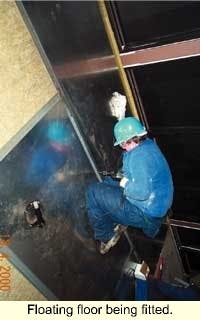Viscoelastic damping technology can achieve 70% noise reduction
Noise and vibration are generated by a myriad of sources onboard ships and offshore platforms. Moreover, they tend to be very efficiently transmitted through the generally stiff, metallic and therefore resonant structures. One common way of overcoming the considerable nuisance this can cause for the occupants is by absorbing the vibration and actually converting it to heat using viscoelastic polymer materials, typically based on polyurethanes or acrylics.
Over the past 20 years, Swedish Acoustic Products - Swedac - has built a track record in overcoming noise and vibration problems using this basic technology. Goran Falk, the company's technical director, claims it is possible to reduce noise levels by 50-70% with the right choice of materials and their effective application.
"Although we have a range of standard products, the skill comes in knowing how best to use them. One also has to keep an open mind about modifying existing products or designing completely new solutions when the conditions require it," he says. Falk believes that sound and vibration suppression should be an integral element of the design of the structure as a whole and not an 'add-on'. For this reason, Swedac offers sound-damping engineering consultancy to ship and offshore platform designers and builders.
The company has supplied over 200,000 m2 of sound-damping deck coverings over the past 15 years. These generally consist of a trowel-applied liquid polymer, which, when dry, is overlaid with an SBR latex concrete. If speed of application is an issue, the liquid-applied polymer can be replaced with an adhesively-bonded polymer sheet.
Where the requirements are more stringent, for example, in laboratory areas, the company can offer a 'floating floor'. This comprises proprietary sound-damping PVP (plate/viscoelastic polymer/plate) laminate plates laid on top of 50mm of mineral wool (140-150 Kg/m3). The sound-damping plates, which were conceived by Swedac, consist of two layers of steel or aluminum, each 2 or 3 mm thick, separated by a thin layer of viscoelastic polymer.
While the performance of this type of system is impressive, even better sound and vibration suppression can be achieved, particularly at the lower frequencies commonly produced by engines, propellers, mud pumps and so on, by combining the floating floor with the company's standard viscoelastic polymer plus SBR latex concrete system (Figure 1). The measured insertion loss, ILv, expressed in dB for this system over a range of frequencies is shown in Figure 2.
Emtunga modules
Swedac has developed similar but thinner (2 mm total) and lighter PVP laminate plates for attaching to bulkheads to reduce noise transmission between cabins. Emtunga has used these extensively in the construction of accommodation modules.
In another variation on this theme, Swedac has supplied single steel sheets to Kvaerner with a layer of viscoelastic polymer that can be easily bonded to an existing steel surface. Kvaerner regularly uses this product on the plinths supporting water injection pumps on offshore platforms.
Recognizing that noise and vibration problems may only manifest themselves when structures have been completed and that older vessels may need to be upgraded, Swedac has also developed a cassette damping system for retro-fitting to bulkheads, vessel sides and beneath floors - essentially anywhere in the noise path - within ships and offshore platforms. These are simply a narrow steel trough containing viscoelastic polymer into which has been set a series of steel lugs to allow welding to the structure.
Swedac supplied its products and services widely in the offshore sector during the 1990s but suffered, like most suppliers, from the downturn towards the end of the decade. It switched its attention to the cruise ship market where it has enjoyed considerable success. Falk believes that the offshore market will recover next year and is hopeful that ever-increasing attention to living and working standards offshore will stimulate even greater demand for his company's products.
For more information contact Goran Falk, Swedac. Tel: +46 31 51 34 90, Fax: +46 31 22 99 60, E-mail: [email protected]



